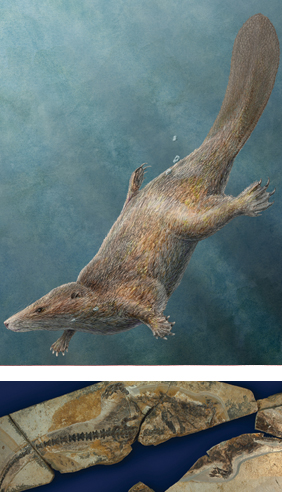 This
illustration of a beaver-like Jurassic mammal is based on a recently discovered
fossil from China (shown below). Images courtesy of Zhe-Xi Luo/CMNH.
This
illustration of a beaver-like Jurassic mammal is based on a recently discovered
fossil from China (shown below). Images courtesy of Zhe-Xi Luo/CMNH.
From beneath layers of ancient ash in China, paleontologists uncovered the fossil of a large beaver-like mammal that lived on land and likely fished in lakes. The discovery, researchers say, could tear down previous stereotypes that mammals, while living alongside dinosaurs, could not develop extensive specialization.
 This
illustration of a beaver-like Jurassic mammal is based on a recently discovered
fossil from China (shown below). Images courtesy of Zhe-Xi Luo/CMNH.
This
illustration of a beaver-like Jurassic mammal is based on a recently discovered
fossil from China (shown below). Images courtesy of Zhe-Xi Luo/CMNH.
Based on previous fossil discoveries, paleontologists thought that land mammals in the Jurassic reached a maximum size of about 20 centimeters (about 8 inches). Essentially, they were thought to always “fit in your hand,” says Zhe-Xi Luo, curator of vertebrate paleontology at the Carnegie Museum of Natural History in Pittsburgh, Pa. Mammals’ small sizes kept them from evolving specialized abilities to dig or climb, he says. But the discovery of Castorocauda lutrasimilis “broke this mold,” says Luo, who with colleagues published the finding in the Feb. 24 Science.
The animal most likely not only could dig with its strong arms; a beaver-like tail suggest that it also could probably take to a lake and capture fish with its sharp teeth — making it the earliest known semi-aquatic mammal. Paleontologists pulled the fossil from below ash sediments that date to about 164 million years old, so the fossil is at least that old, Luo says. Until now, the earliest semi-aquatic mammals discovered were from between 25 and 55 million years ago.
But size was the first thing that struck Luo about C. lutrasimilis. When colleague Qiang Ji, from the Chinese Academy of Geological Sciences, showed the fossil to Luo, they instantly recognized that the fossil was that of “a different kind of mammal” as-yet unknown to researchers “because it was so huge,” Luo says. At almost 50 centimeters long (about half a yard), C. lutrasimilis certainly would not fit in a paleontologist’s hand.
Luo and Ji also found fossilized hairs from the mammal’s pelt, which, similar to modern beavers, likely kept water away from its skin. This finding, along with its size and fish-eating teeth, provide evidence that C. lutrasimilis had specialized to fill a niche, and that mammals diversified and specialized much sooner than previously thought, Luo says. Something, however, did not work out for C. lutrasimilis: Although it resembles beavers today, the researchers say that the mammal eventually became extinct and has no direct relation to modern mammals.
Kathryn Hansen
 |
Geotimes Home | AGI Home | Information Services | Geoscience Education | Public Policy | Programs | Publications | Careers |